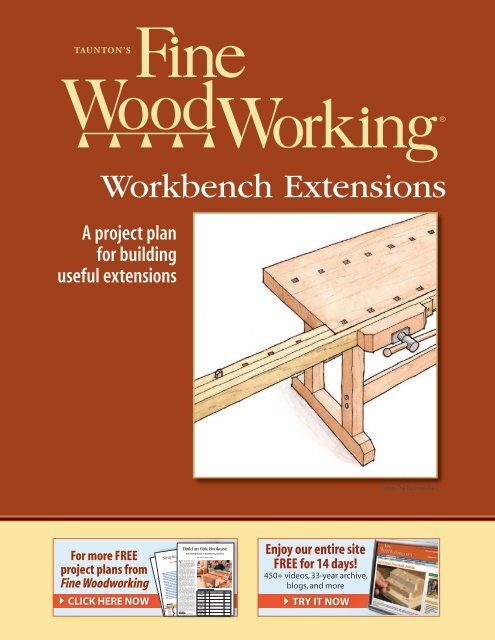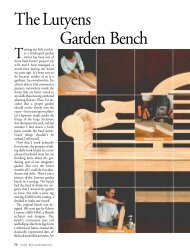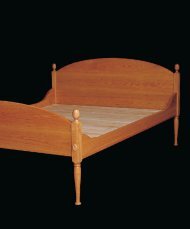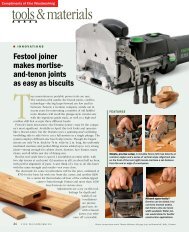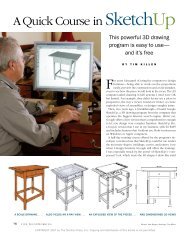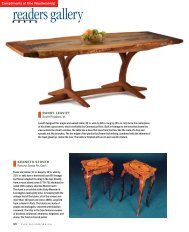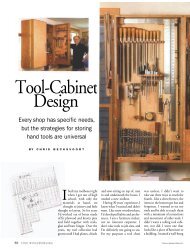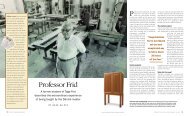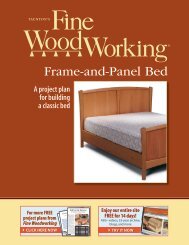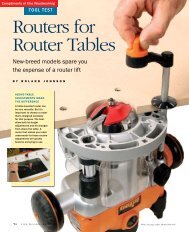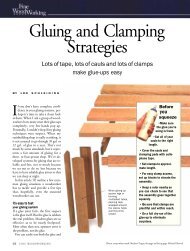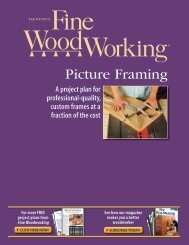Workbench Extensions - Fine Woodworking
Workbench Extensions - Fine Woodworking
Workbench Extensions - Fine Woodworking
Create successful ePaper yourself
Turn your PDF publications into a flip-book with our unique Google optimized e-Paper software.
24 in.<br />
24 in.<br />
Side<br />
3½ in.<br />
Side<br />
1 ⁄ in.<br />
3½ in.<br />
1 ⁄ in.<br />
17 in.<br />
17 in.<br />
ou can thank Mike Pekovich,<br />
<strong>Fine</strong> <strong>Woodworking</strong>’s art director,<br />
for designing this simple but<br />
stylish bookcase. He took a straightforward<br />
form--an oak bookcase with dado<br />
and rabbet joints--and added nice proportions<br />
and elegant curves.<br />
We agreed that screws would reinforce<br />
the joints nicely, and that gave us a design<br />
option on the sides. Choose oak<br />
plugs, and align the grain carefully, and<br />
the plugs disappear. Make them from a<br />
contrasting wood, like walnut, and the<br />
rows of plugs add a nice design feature<br />
to the broad sides, hinting at the construction<br />
in a subtle way.<br />
By design the bookcase contains a<br />
number of fundamental lessons for<br />
would-be furniture-makers, and like the<br />
other projects in this video series, the<br />
whole thing can be built with just a few<br />
portable power tools: a circular saw, a<br />
drill, and a router<br />
The shelves attach to the sides with<br />
simple dadoes, and the back and backsplash<br />
drop into rabbets. Screws reinforce<br />
the dado joints and also attach the<br />
lower stretcher, and wood plugs cover<br />
the screw holes. Smaller wood screws<br />
are used to attach the plywood back.<br />
Curves add life to rectangular pieces<br />
of furniture, and Pekovich worked in<br />
three types, each irregular and organic<br />
(as opposed to radius curves that can<br />
seem mechanical). At the top are gentle<br />
curves that speed up as they move<br />
forward, each taken from a section of<br />
a French curve. At the bottom are two<br />
long curves formed with a flexible wood<br />
batten, one extending end to end on the<br />
lower stretcher, and the other a short<br />
graceful arch at the bottom of the sides,<br />
ending at a straight step at each end to<br />
suggest legs.<br />
--Asa Christiana, editor, <strong>Fine</strong> <strong>Woodworking</strong><br />
1 ⁄ in.<br />
1½ in.<br />
1 ⁄ in.<br />
2 ⁄ in.<br />
1½ in.<br />
2 ⁄ in.<br />
VIDEOS<br />
9 ⁄ in.<br />
10 in.<br />
9 ⁄ in.<br />
10 in.<br />
B Y A S A C H R I S T I A N A<br />
LUMBER AND HARDWARE LIST<br />
PART QTY SIZE MATERIAL<br />
SIDES<br />
SHELVES<br />
62 in.<br />
BACK SPLASH<br />
ARCHED<br />
STRETCHER<br />
BACK<br />
SCREWS FOR<br />
SHELVES<br />
SCREWS FOR<br />
BACK<br />
62 in.<br />
41 in.<br />
41 in.<br />
48 in.<br />
48 in.<br />
3 ⁄ in.<br />
3 ⁄ in.<br />
4 in.<br />
1 ⁄ in.<br />
1 ⁄ in.<br />
4 in.<br />
1 ⁄ in.<br />
33 ⁄ in.<br />
1 ⁄ in.<br />
TAUNTON’S<br />
<strong>Workbench</strong> <strong>Extensions</strong><br />
A project plan<br />
for building<br />
useful extensions<br />
©2009 The Taunton Press<br />
For more FREE<br />
project plans from<br />
<strong>Fine</strong> <strong>Woodworking</strong><br />
click here now<br />
S i m p l e , S t u r d y Wo r k b e n c h<br />
T<br />
S i m p l e , S t u r d y Wo r k b e n c h<br />
T<br />
From Getting Started in <strong>Woodworking</strong>, Season 2<br />
From Getting Started in <strong>Woodworking</strong>, Season 2<br />
his workbench is easy and inexpensive<br />
to build, yet is sturdy and versatile<br />
enough for any woodworker. The base is<br />
construction lumber (4x4s and 2x4s), joined<br />
simply with long bolts and short dowels. The<br />
top is two layers of MDF (medium-density<br />
fiberboard), cut from a single sheet, with<br />
enough left over to make a handy shelf.<br />
The only tools needed to make this bench<br />
are a dri l/driver, a circular saw, and a handheld<br />
router or a router table.<br />
There is room at one end for a smal castiron<br />
woodworking vise, which is an essential<br />
tool in any woodworking shop. The vise is<br />
fitted with non-maring wooden jaws, and the<br />
jaws and benchtop receive dog holes, sized<br />
to fit a variety of handy bench accessories.<br />
stretchers<br />
VIDEOS<br />
B Y A S A C H R I S T I A N A<br />
B Y A S A C H R I S T I A N A<br />
his workbench is easy and inexpensive<br />
to build, yet is sturdy and versatile<br />
enough for any woodworker. The base is<br />
construction lumber (4x4s and 2x4s), joined<br />
simply with long bolts and short dowels. The<br />
top is two layers of MDF (medium-density<br />
fiberboard), cut from a single sheet, with<br />
enough left over to make a handy shelf.<br />
The only tools needed to make this bench<br />
are a dri l/driver, a circular saw, and a handheld<br />
router or a router table.<br />
There is room at one end for a sma l castiron<br />
woodworking vise, which is an essential<br />
tool in any woodworking shop. The vise is<br />
fitted with non-maring wooden jaws, and the<br />
jaws and benchtop receive dog holes, sized<br />
to fit a variety of handy bench accessories.<br />
stretchers<br />
VIDEOS<br />
Y<br />
Build an Oak Bookcase<br />
From Getting Started in <strong>Woodworking</strong>, Season 2<br />
LUMBER, HARDWARE AND SUPPLIES LIST<br />
4 8-ft.-long 2x4s, kiln-dried<br />
2 8-ft.-long 4x4s, kiln-dried<br />
1 4x8 sheet of MDF<br />
2 Hardwood pieces for vise jaws, 7½ in. long by 3 in. wide. Front jaw can be<br />
between 1 in. and 1½ in. thick and the rear jaw is ¾ in. thick.<br />
1 Filer block for mounting vise, ¾-in.-thick plywood, 4 in. wide by 6 in. long<br />
1 bo tle of yelow glue<br />
1 7-in. Groz Rapid-Action <strong>Woodworking</strong> Vise (www.woodcraft.com)<br />
4 6-ft. lengths of ⁄ -in.-dia. threaded rod<br />
16 ⁄ -in. washers<br />
16 ⁄ -in. nuts<br />
2 2-in.-long ¼-20 bolts, nuts, washers for a taching front jaw of vise<br />
2 1½-in.-long, ¼-20 flathead screws for a taching rear jaw<br />
1 Box of 1¼-in.-long drywal screws for laminating benchtop<br />
4 ⁄ -in.-dia., 2½-in.-long lag screws and washers, for a taching vise<br />
16 S-clip-type tabletop fasteners<br />
16 ⁄ -in.-dia. dowels, roughly 3 in. long<br />
LUMBER, HARDWARE AND SUPPLIES LIST<br />
4 8-ft.-long 2x4s, kiln-dried<br />
2 8-ft.-long 4x4s, kiln-dried<br />
1 4x8 sheet of MDF<br />
2 Hardwood pieces for vise jaws, 7½ in. long by 3 in. wide. Front jaw can be<br />
between 1 in. and 1½ in. thick and the rear jaw is ¾ in. thick.<br />
1 Filer block for mounting vise, ¾-in.-thick plywood, 4 in. wide by 6 in. long<br />
1 bo tle of yelow glue<br />
1 7-in. Groz Rapid-Action <strong>Woodworking</strong> Vise (www.woodcraft.com)<br />
4 6-ft. lengths of ⁄ -in.-dia. threaded rod<br />
16 ⁄ -in. washers<br />
16 ⁄ -in. nuts<br />
2 2-in.-long ¼-20 bolts, nuts, washers for a taching front jaw of vise<br />
2 1½-in.-long, ¼-20 flathead screws for a taching rear jaw<br />
1 Box of 1¼-in.-long drywal screws for laminating benchtop<br />
4 ⁄ -in.-dia., 2½-in.-long lag screws and washers, for attaching vise<br />
16 S-clip-type tabletop fasteners<br />
16 ⁄ -in.-dia. dowels, roughly 3 in. long<br />
Long stretchers<br />
Long stretchers<br />
33 ⁄ in.<br />
9 in. 9 ⁄ in.<br />
9 in. 9 ⁄ in.<br />
Visit us online at <strong>Fine</strong><strong>Woodworking</strong>.com/Star to watch a two-part video detailing how to build this workbench from star to finish.<br />
Visit us online at <strong>Fine</strong><strong>Woodworking</strong>.com/Star to watch a two-part video detailing how to build this workbench from star to finish.<br />
Enjoy our entire site<br />
FREE for 14 days!<br />
450+ videos, 33-year archive,<br />
blogs, and more<br />
try it now
<strong>Workbench</strong> extension<br />
lengthens clamping capacity<br />
A few years ago, one of my customers wanted a<br />
12-ft.-long tapered flagpole. My plan was to make<br />
an octagonal blank and then use a handplane to<br />
shape it into a tapered cylinder. But the pole was 5<br />
ft. longer than my bench, and that introduced a<br />
clamping problem.<br />
My solution was this workbench extension that effectively<br />
lengthened clamping capacity by several<br />
feet. Now that I have the extension, I use it whenever<br />
I have a workpiece longer than my bench, such<br />
as bedposts, tabletops, and countertops.<br />
—Aurelio Bolognesi, Hardwick, Mass.<br />
<strong>Workbench</strong><br />
extension<br />
Benchdog<br />
Benchdog<br />
Block prevents the extension<br />
from slipping in the vise.<br />
Dadoes in the outside<br />
leg create holes for<br />
the benchdog.<br />
Adjust the thickness of the<br />
center leg so that the dog<br />
holes in the extension align<br />
with those in the bench.<br />
Outside 2x6 leg,<br />
5 ft. long<br />
Block is glued<br />
and screwed to<br />
the main leg.<br />
Main 2x6 leg, 7 ft. long


